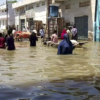Massive floods have resulted in the displacement of nearly a quarter of a million people in central Somalia, as the Shabelle River burst its banks and engulfed the town of Beledweyne. This catastrophe unfolds at a time when the country is already grappling with its worst drought in 40 years, as reported by the government. The convergence of these two natural disasters underscores the impact of the climate crisis on vulnerable populations, despite their minimal contribution to carbon dioxide emissions.
The flash floods, triggered by seasonal rains in Somalia and the Ethiopian highlands, have obliterated homes, crops, and livestock, while causing temporary closures of schools and hospitals in Beledweyne, the capital of the Hiiraan region. Ahmed Nur, a shopkeeper who witnessed the deluge, described the city being transformed into an underwater landscape, with only the roofs of houses visible. Rescue efforts were conducted using small boats and tractors to save stranded individuals.
Previously celebrating the end of a devastating drought, residents now face the harrowing aftermath of the floods. The drought, compounded by violence and skyrocketing food prices due to the conflict in Ukraine, resulted in the deaths of up to 43,000 people last year, according to the United Nations. Since mid-March, the floods have affected over 460,000 people nationwide and claimed the lives of 22 individuals, as reported by the UN’s humanitarian office.
In Beledweyne alone, the floods have forced more than 245,000 people to flee their homes, as stated by the Somali Disaster Management Agency. The recovery process from six consecutive seasons of poor rainfall will be protracted, according to the UN humanitarian office. While the current rains are replenishing water sources and fostering vegetation regrowth, a significant amount of rainfall is required to effectively mitigate the impact of the recent drought.
Halima Abdullahi, a resident of Beledweyne and mother of two, expressed her resignation and determination to move away from the city, joining the estimated 216 million people projected by the World Bank to be internally displaced by 2050 due to climate-related stresses. With Beledweyne no longer recognizable in the wake of back-to-back disasters, Abdullahi and others face the grim reality of seeking refuge in distant villages.
The situation highlights the urgent need for comprehensive climate action and support for communities impacted by climate-related disasters.











